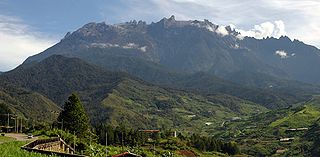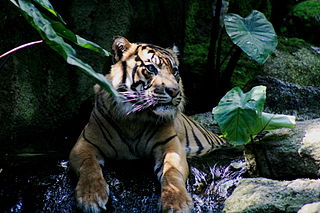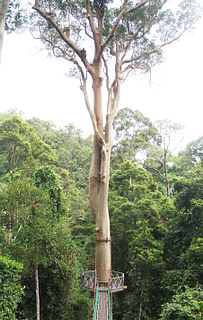
Borneo is the third-largest island in the world and the largest in Asia. At the geographic centre of Maritime Southeast Asia, in relation to major Indonesian islands, it is located north of Java, west of Sulawesi, and east of Sumatra. The island was named after the nation of Brunei.

Sumatra is one of the Sunda Islands of western Indonesia. It is the largest island that is entirely governed by Indonesia and the sixth-largest island in the world at 473,481 km2.

Mountain Kinabalu is a mountain located at the West Coast Division of Sabah, Malaysia. It is protected as Kinabalu Park, a World Heritage Site. Kinabalu is the highest peak in Borneo's Crocker Range and is the highest mountain in the Malay Archipelago as well as the highest mountain in Malaysia. Mount Kinabalu is also the 20th most prominent mountain in the world by topographic prominence.

The bay cat, also known as Borneo bay cat and Bornean bay cat, is a wild cat endemic to the island of Borneo that appears to be relatively rare compared to sympatric wild cats, based on the paucity of historical, as well as recent records. Since 2002, it has been listed as Endangered on the IUCN Red List because it is estimated that fewer than 2,500 mature individuals exist, and that the population declined in the past. The bay cat has been recorded as rare and seems to occur at relatively low density, even in pristine habitat.

The otter civet is a semiaquatic civet native to Thailand, Malaysia, Indonesia and Brunei. It is listed as Endangered because of a serious ongoing population decline, estimated to be more than 50% over the past three generations, inferred from direct habitat destruction, and indirect inferred declines due to pollutants.

The Tabin Wildlife Reserve is a nature preserve in Sabah, Malaysia. It was created in 1984 to preserve Sabah's disappearing wild animals. Occupying a large part of the peninsula forming the northern headland of Darvel Bay, it is located 48 kilometres east of Lahad Datu.

Danum Valley Conservation Area is a 438 square kilometres tract of relatively undisturbed lowland dipterocarp forest in Sabah, Malaysia. It has an extensive diversity of tropical flora and fauna, including such species as the rare East Sumatran rhinoceros, Bornean orangutans, gibbons, mousedeer, clouded leopards and over 270 bird species. Activities offered are jungle treks, river swimming, bird watching, night jungle tours and excursions to nearby logging sites and timber mills.

The Borneo peat swamp forests ecoregion, within the tropical and subtropical moist broadleaf forests biome, are on the island of Borneo, which is divided between Brunei, Indonesia and Malaysia.

The Bornean orangutan is a species of orangutan native to the island of Borneo. Together with the Sumatran orangutan and Tapanuli orangutan, it belongs to the only genus of great apes native to Asia. Like the other great apes, orangutans are highly intelligent, displaying tool use and distinct cultural patterns in the wild. Orangutans share approximately 97% of their DNA with humans.

Borneo is the third largest island in the world. In prehistoric times it was connected to the Asian mainland due to geological and climate changes. During the recent ice ages of the Pleistocene and the Holocene separation from the mainland caused extinctions and speciation of fauna on the island.

The fauna of Indonesia is characterised by high levels of biodiversity and endemicity due to its distribution over a vast tropical archipelago. Indonesia divides into two ecological regions; western Indonesia which is more influenced by Asian fauna, and the east which is more influenced by Australasian species.

The wildlife of Malaysia is diverse, with Malaysia being a megadiverse country. Most of the country is covered in rainforest, which hosts a huge diversity of plant and animal species. There are approximately 361 mammal species, 694 bird species, 250 reptile species and 150 frog species found in Malaysia. Its large marine territory also holds a great diversity of life, with the country's coastal waters comprising part of the Coral Triangle.

Koompassia excelsa is an emergent tropical rainforest tree species in the family Fabaceae. It is found in Indonesia, Malaysia, the Philippines, and Thailand. It is one of the tallest tropical tree species: the tallest measured specimen is 85.8 m or 88 m(281 or 289 ft) tall.

Betung Kerihun National Park is a national park in the province of West Kalimantan on the island of Borneo, Indonesia. It is located inland, along the Malaysian border. The park was established in 1995, and has a total area of 8,000 km2 (3,100 sq mi) or about 5.5 percent of West Kalimantan Province area. Together with the 2,000 km2 (800 sq mi) Lanjak Entimau Wildlife Sanctuary in Malaysia, it has been proposed to form a World Heritage Site named the "Transborder Rainforest Heritage of Borneo".

Tanjung Puting National Park is a national park in Indonesia located in the southeast part of West Kotawaringin Regency in the Indonesian province of Central Kalimantan. The nearest main town is the capital of the Regency, Pangkalan Bun. The park is famous for its orangutan conservation.

The environment of Malaysia refers to the biotas and geologies that constitute the natural environment of this Southeast Asian nation. Malaysia's ecology is megadiverse, with a biodiverse range of flora and fauna found in various ecoregions throughout the country. Tropical rainforests encompass between 59% to 70% of Malaysia's total land area, of which 11.6% is pristine. Malaysia has the world's fifth largest mangrove area, which totals over a half a million hectares.

Deforestation in Borneo has taken place on an industrial scale since the 1960s. Borneo, the third largest island in the world, divided between Indonesia, Malaysia and Brunei, was once covered by dense tropical and subtropical rainforests.
The Borneo montane rainforests are an ecoregion, of cloud forest, within the tropical and subtropical moist broadleaf forests biome, of the island of Borneo in Southeast Asia.
The Borneo is located in Sunda Shelf which is an extensive region in Southeast Asia of immense importance in terms of biodiversity, biogeography and phylogeography of fauna and flora that had attracted AR Wallace and biologists all over the world.

















